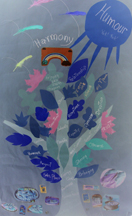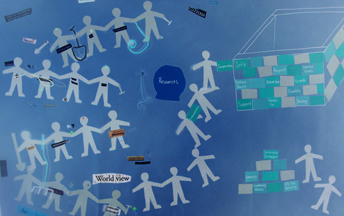The Learning Circles Project |
||
| The Storytelling Group by Tracey Mollins | ||
Valuing Elders at Parliament and Gerrard in Downtown TorontoThe Storyteller’s Group meets at the Yonge Street Mission site called the Christian Community Centre at Parliament and Gerrard, where some of Toronto’s economically poorest and richest come together. The Storyteller’s Group meets on Thursday afternoons. The group is advertised as a place to “learn to tell stories that make people want to listen” and is for seniors and adults over forty-years old. Many of those who attend the group meet first at the Seniors’ Community Lunch and have the option of attending the storytelling group, a sewing group or a drop in after lunch. The motivation for starting the storytelling group came from its funder. Gwen Harvey is the administrator of her parent’s foundation. She learned about a group from New York called Elder Share the Arts. Founded in 1979, …ESTA's central strategy is bringing together young people and the elderly using the medium of the visual and dramatic arts. Storytelling, with a focus on oral history and intergenerational communication, is a key focus. Exhibitions celebrating the work of older artists and in-school programmes that feature interaction between young people and older adults are also central. from www.elderssharethearts.org/main.html Harvey decided to start a group for seniors here in Toronto. She was particularly interested in a group for participants to work on personal stories. She wanted the group to be a place for people to work on the skills of telling stories effectively and a place where a sense of wellness was fostered and nurtured. She felt that the group would break the isolation experienced by some seniors and that people would see that their stories are valued in the community. She is looking to recapture the sense of older as elder. Harvey approached the YSM and the YSM approached Storytellers School of Toronto (www.storytellingtoronto.org) with a request for proposals; six were submitted and the one from Bruce Carmody, the former president of the STS, was chosen.. Carmody attended one of the lunches at the YSM and told some stories to introduce the idea and invite people to the group. The group was also advertised throughout the YSM and at the library. Most of the people who come to the group are from the YSM. People have a variety of reasons for attending: some come because they have always been nervous talking in front of other people and want to work on that, some come because this was the most attractive option and others come because they cannot sew. Some of the participants were worried about joining the group because they equate storytelling with gossip. The storytelling group meets in a small chapel and the storytellers are surrounded by rich wood, stained glass and a panoramic view of Parliament Street. The day I attended the group there were eight participants plus Carmody; four women and four men. One of the challenges of working with this group is that different people are able to come each week. Carmody has to balance making the sessions progressive for regular attendees and accessible and interesting to new participants or participants who may have been absent due to illness, family responsibilities or other events. After greetings, introductions and an explanation of why I was there, Carmody started by asking, “Did you tell any stories this week?” It seemed that no one had, but after giving some examples of what telling a story might look like, some people found that they had. Carmody then showed the participants a diggerydoo that he had been given upon retiring from STS. He told them that he had been given the diggerydoo to use as a talking stick and explained how talking sticks are used by storytellers: whoever is speaking holds the stick until they are finished and then they pass the stick to the next speaker. Carmody talked about how the decoration on the stick was like a story. The decoration showed a thread from beginning to end but not a straight line. Participants looked at the decoration and thought that it represented a life path. They related how particular patterns represented specific times in their lives. Some thought that the sparseness of the pattern at each end and the denseness in the middle represented the fact that our lives are full of activity and responsibility in middle age and less complicated when we are young and when we are old. This led to the recounting of some journeys they had taken. All of the women and one man had grown up in the Caribbean and moved to Canada as adults. Some of them spoke of the feelings of isolation and fear when they first came here leaving friends and family, including children, at home. They spoke of how difficult it was to find work and respectful employers, how difficult it was to gain status as landed immigrants and then citizenship, and how difficult it was to get used to the weather and the community they found here in Toronto. After this discussion, Carmody asked everybody to think of things in their homes that they consider to be treasures. He gave everybody a notebook and pencil and asked them to write the list. One man said that he could not write it and Carmody told him that was okay and he should think about his list. It was not clear whether it was the writing or the task itself that this participant was struggling with. When it came time to share, he did not. Carmody said later that this was the first time this man had attended the group. The participants were asked to talk about one treasure. Some people spoke about a photograph of a family member they do not see often, usually a child or grandchild. Some people spoke of a household item - a jug, a china ornament, an afghan - that had value because of the connection to the person who had given it to them. One man told us about an art project, his very first stained glass sculpture. We, the listeners, could see the seeds of stories as each one talked about their treasures. The last activity of the session was for Carmody to tell the participants a traditional story. After listening, the group discussed the content and structure of the story and how they might apply this structure to their own stories. Carmody likes to include a traditional tale in each session. Traditional tales are well-honed and provide models for how to develop new stories. He tries to find stories where the wisdom of elders is the key to solving problems and dilemmas posed in the stories. Carmody speaks about how the telling of stories works to unlock memories and the relationship between oral story telling and literacy. For seniors, the value of telling stories lies in seeing their experience and knowledge as something valuable and worth passing on. Storytelling helps people see themselves as elders – the keepers and teachers of a history and culture that is as important to the present as it was in the past. The storytelling group can reactivate the learner in some seniors as they learn techniques of storytelling. As they explore, not just how to tell their own story, but how to find themselves in other stories, some develop a deeper sense of connection and community. For children, listening to stories gets them excited about stories in general; often after listening to a story about Anansi or another folktale, children are full of questions about how they can find more stories like that one and are eager to get to the library. This is another reason that Carmody would like The Storyteller’s Group to work on some traditional tales. He would like them to work with children from neighbourhood schools. The personal stories may not have the same resonance for children nor the connection to books they can find in the library. Carmody sees an opportunity for these two groups to come together. If seniors can move into the community and perform stories for children, they will see themselves as teachers as well as learners and as important to the development and growth of their community. Children will learn to value the contributions of seniors, see through the stereotypes associated with aging and get excited about stories and reading. He would like to develop a library of tellable tales for the seniors. He feels that performance is part of storytelling and that if the group sticks exclusively to telling personal tales, the public performance piece may be difficult for people who are not comfortable speaking about their own lives in front of strangers. He would like funding to develop this library and to support seniors telling stories to children in the community. This would include making videos and CDs of the seniors telling stories. The group has already begun this work: they have recorded a CD that they have presented to the YSM; they have adapted a story and done a public performance of it for children; and they have made a video on DVD that they hope to use as the basis of a documentary about the group and the process of how they develop their stories. They plan to approach Ryerson to see if a student there would be interested in working with them on the documentary. |
||

